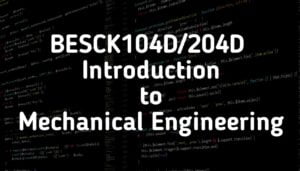
BESCK104D/204D Introduction to Mechanical Engineering
Syllabus Copy
Module - 1
Introduction:
Role of Mechanical Engineering in Industries and Society- Emerging Trends and Technologies in different sectors such as Energy, Manufacturing, Automotive, Aerospace, and Marine sectors.
Energy:
Introduction and applications of Energy sources like Fossil fuels, Nuclear fuels, Hydel, Solar, wind, and bio-fuels, Environmental issues like Global warming and Ozone depletion
Module - 2
Machine Tool Operations:
Working Principle of lathe, Lathe operations: Turning, facing, knurling. Working principles of Drilling Machine, drilling operations: drilling, boring, reaming. Working of Milling Machine,
Milling operations:
plane milling and slot milling. (No sketches of machine tools, sketches to be used only for explaining the operations). Introduction to Advanced Manufacturing Systems: Introduction, components of CNC, advantages and applications of CNC, 3D printing.
Module - 3
Introduction to IC Engines:
Components and Working Principles, 4-Strokes Petrol and Diesel Engines, Application of IC Engines.
Insight into Future Mobility;
Electric and Hybrid Vehicles, Components of Electric and Hybrid Vehicles. Advantages and disadvantages of EVs and Hybrid vehicles.
Module - 4
Engineering Materials:
Types and applications of Ferrous & Nonferrous Metals, silica, ceramics, glass, graphite, diamond and polymer. Shape Memory Alloys.
Joining Processes:
Soldering, Brazing and Welding, Definitions, classification of welding process, Arc welding, Gas welding and types of flames.
Module - 5
Introduction to Mechatronics and Robotics:
open-loop and closed-loop mechatronic systems. Classification based on robotics configuration: polar cylindrical, Cartesian coordinate and spherical. Application, Advantages and disadvantages. Automation in industry: Definition, types – Fixed, programmable and flexible automation, basic elements with block diagrams, advantages.
Introduction to IOT:
Definition and Characteristics, Physical design, protocols, Logical design of IoT, Functional blocks, and communication models.
Hello, off course this article is in fact good and I have learned lot of things from
it concernng blogging. thanks. https://ukrain-forum.Biz.ua/